Affiliate disclosure: This post may contain affiliate links. Please see our Privacy Policy.
Common milkweed is a tasty edible plant, and one of my favorite spring greens. That’s right my friends…milkweed is edible, and wicked tasty. It tastes remarkably like asparagus, only better.
Every time I tell someone this, they immediately say, “Shhh…don’t tell people. We have to save it for the Monarchs!” The truth is, eating milkweed can and will actually help the monarchs.
Let me tell you why…
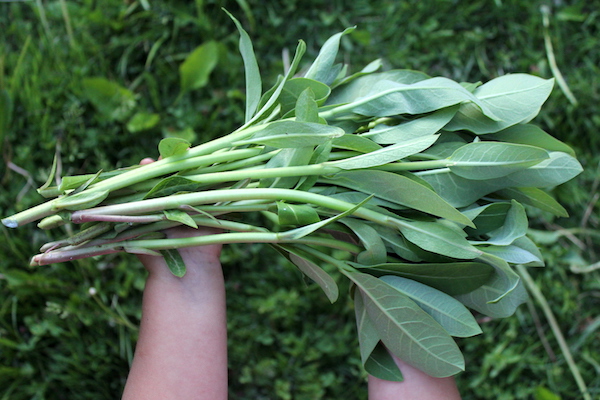
(Important: There are a lot of species of Milkweed, and I’m referring to common milkweed (Asclepias syriaca). It does have toxic look-alikes, and if you’re not 100% sure on your ID, don’t eat it. I’d strongly suggest a good foraging guide, like The Forager’s Harvest, which contains detailed information on identifying and foraging milkweed, and/or a foraging course covering basic botany and ethical foraging.)
I’ve seen foragers get a lot of pushback for even talking about eating milkweed. There’s this thought that, if the general public knows that milkweed is not only edible, but delicious, then they’ll eat it all up and there won’t be any for the monarchs.
Reality is just the opposite. Tell people that it’s delicious, and they’re less likely to weed them out of the garden. They’ll tend it carefully, and go out of their way to plant it, knowing that if it’s carefully stewarded you can harvest “wild” milkweed alongside their other vegetables.
Common Milkweed (Asclepias syriaca) is a perennial plant, and with a little care, it can be harvested at all stages of development and it will regrow with increased vigor.
Imagine a plant you can cut in the early stages like asparagus. Then later, when it resprouts, the flower buds can be harvested like broccoli. Then, the flowers themselves are tasty edible flowers.
Leave a few flowers, and after the bees are done with them, the young pods can be cooked like okra. A few weeks later, the immature seeds make a vegan cheese substitute.
Every stage is edible, and milkweed has a new gift to give every week of the summer.
(If you can’t find milkweed in the wild, that’s all the more reason to plant it yourself. All you need is a few Milkweed Seed Packets, and it’ll grow like a weed.)
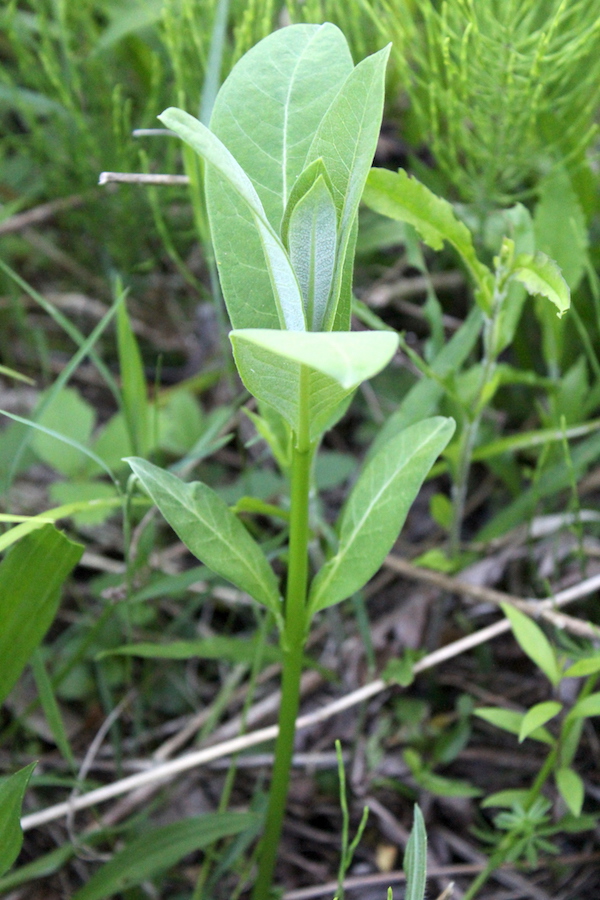
Eating Milkweed, and Human Nature
I love the Monarchs, but I still used to weed milkweed out of the garden every year. It invades my asparagus patch with a vengeance.
I consider myself a serious nature lover, but I’m also a lover of asparagus you see. There’s a wild patch of milkweed around the pond, I’ll save that for the butterflies, but my asparagus bed is my own.
As soon as I learned that milkweed is not only edible, it’s actually better than asparagus…well that was a game-changer for me. I no longer weed it out, and it happily grows alongside my other edibles.
This simple knowledge changed the way I weed my garden, and I’m already a nature lover. Imagine what it might do for someone that doesn’t care one bit about butterflies…
Someone that sprays roundup with wild abandon and that keeps a can of Raid on hand for every stray ant that wanders onto the property? I know those people, they’re my parents.
While they’d never consciously grow anything on behalf of an insect, they would happily plant a packet of seeds for a fragrant perennial flower that happens to taste delicious. They’ll buy seed packs and plant it, tell their friends not to mow it, and smile when they see it growing at the edge of a park…
Or at the very least, they’ll skip it as they’re walking around with the jug of round-up. Baby steps, and a little progress at least.
Self-interest is a lot stronger than the abstract thought that you’re saving milkweed for the monarchs.
Still Not Convinced?
I was happy enough knowing that milkweed is edible, and encouraging others to grow it on their own land. I recently learned though, foraging milkweed in the wild might actually directly help the monarchs. Nomi Foraging discusses this, in relation to his region of Northern Michigan.
“Overwintering sites for these migrating butterflies are in a variety of locations in the southern US and in Mexico. Coupling that fact with their relatively short lifespan of only 2-5 weeks, we know that the Monarch populations that we see in Northern Michigan could be 4-5 generations removed from the original traveler. It is vital for these migrators to arrive here with a hefty supply of food to feed their young. The paradox here is that the most endemic species of Milkweed in our area, and their preferred food source is the Common Milkweed, and by the time these butterflies arrive in Michigan our Common Milkweeds may be too old and tough for most of the Monarch caterpillars to feed on!
This is where we foragers get to help in the cause by feeding ourselves. Over my years of teaching foraging, I have come to see that occasionally a selfish act is actually the opposite. It’s what I would call a win-win-win. We benefit, by getting to eat a delicious and healthy vegetable, the Monarchs benefit with fresh and tender leaves to feed their young, and the Milkweed benefits because rhizomatic plants grow more dense with disturbance. Common Milkweed spreads by underground rhizome, which is to say that the portion that you see above ground is not all there is to this story. This underground rhizome spreads rapidly underground creating clonal colonies of milkweed that all originate from the same source. When Common Milkweed is cut back to the ground, it has the amazing ability to resprout from its rhizome. Which works out wonderfully for both the Monarchs, the Milkweed, and us humans.”
I am no expert on Monarch butterfly life cycles, but he does make a good argument.

Is Milkweed Toxic?
Reminder: There are a lot of species of Milkweed, and I’m referring to common milkweed (Asclepias syriaca). Make sure you cook it thoroughly and start with small amounts because there’s always the possibility of a reaction when eating any new food, foraged or otherwise.
There is one account in a foraging book from the 1970’s where an author actually misidentified a plant thinking it was milkweed (dogbane instead of milkweed). Dogbane is toxic, and tastes horrible.
Since then, hundreds of resources have just copied that information without checking, each one says “it’s unpalatably bitter.” While dogbane is horribly bitter and toxic, common milkweed is not. Milkweed is sweet and tender, and just one bite of a spring shoot sauteed in butter and you’ll know “unpalatably bitter” is far off the mark.
That incorrect information has been perpetuated for decades, with source after source labeling the plant as “toxic.”
As always, with any wild edible use your best judgment and consult plenty of sources before making a decision to eat it, don’t just take my word for it. In any case, there are toxic look-alikes for common milkweed, so be 100% sure on your identification too.
I’d highly recommend Samuel Thayer’s Book, The Forager’s Harvest, which contains detailed information on identifying and foraging milkweed (and avoiding toxic dogbane).
There’s always a chance you personally might have a reaction to any new food, so explore with caution, and never eat more than a bit at any sitting.
Here are a few resources from other foragers on milkweed, each with their own spin on this tasty plant:
- Cooking Milkweed Shoots from Forager Chef
- Foraging Milkweed from Countryside Daily (by Sam Thayer, one of the best-known foragers in the field today)
- Cooking Milkweed from Eat the Weeds
- Milkweed as a Vegetable from the Maine Organic Farmer’s Association
How to Cook Milkweed
Ok, so milkweed is edible. Now what? How on earth do you cook it?
That really depends a lot on when you find milkweed in the wild, or harvest it from your milkweed veggie patch. The first edible stage is the young shoots and leaves.
Start by collecting the shoots when they’re about 8” tall. Strip off the leaves and cook them separately (as I did) or leave them on the stalks, no matter.
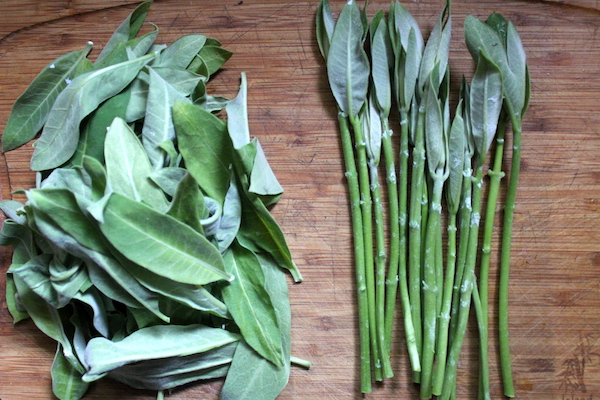
Milkweed shoots sauteed in a bit of butter are absolutely delicious, and much better than my painstakingly tended asparagus patch. I’d put them up there with garden hosta shoots (which are also edible), but only more buttery and smooth.
I cook them up in a pan with a bit of butter, then finish with a sprinkle of salt.
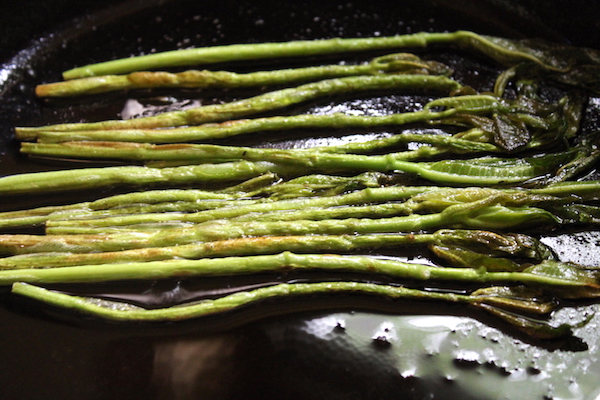
The leaves are just as tasty sauteed in butter, but they cook much faster. They really only need about 2 minutes in a hot pan, and then they’re a delicious cooked green that I’d put on par with young arugula. If you’ve never had arugula cooked in butter, you might think bitter, but arugula is tender and mild when you cook it.
Just like milkweed greens…
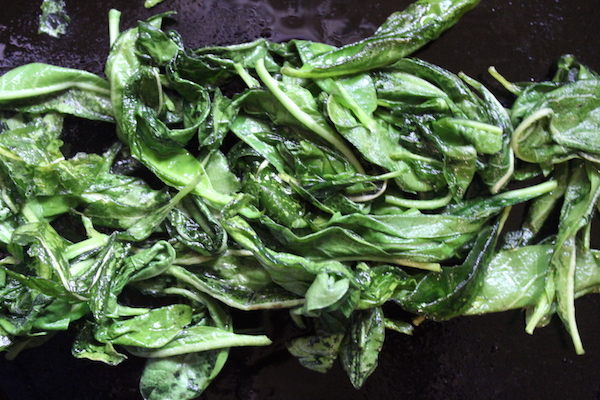
The next gift of the milkweed is the flower buds. I’ve read them described as “broccoli from another planet” which isn’t a bad way to put it.
They taste like a green vegetable, but with a really crazy popping texture like a spoon full of rice crispies cereal. They bite back a bit, in a pleasant way that really makes them interesting to eat.
I cook them up in the same way as the shoots and leaves, with a hot pan and some butter. If you want to get more creative, you can make them into Milkweed Capers, which are a fun wild-harvested caper substitute that’s really easy to make.
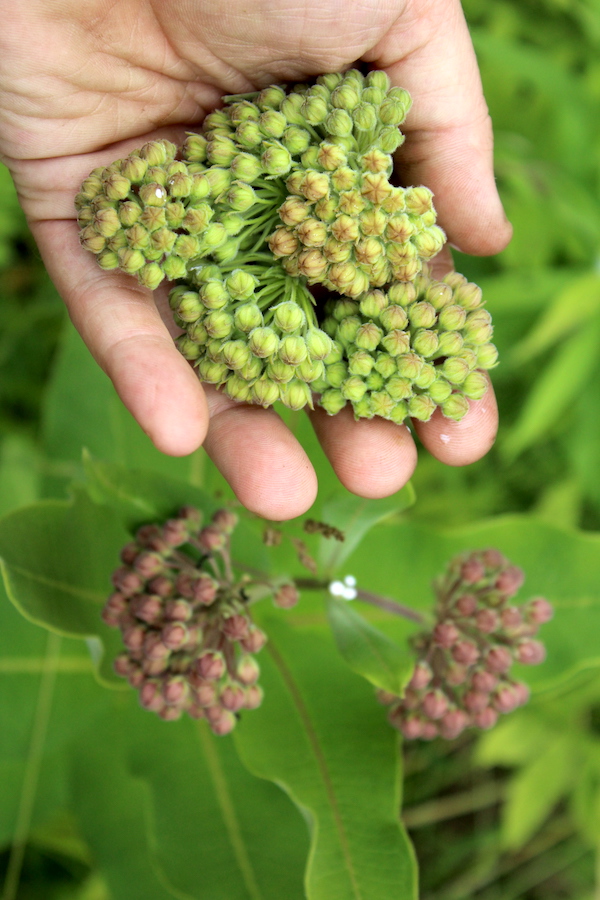
Once the flower buds open, the fragrant milkweed flowers can be eaten just like any edible flower. This is a really creative and detailed guide on cooking milkweed flowers, along with sorbet, cordial and a number of other fun ideas.
I haven’t worked with the flowers personally, mainly because I simply love sitting out and enjoying their intoxicating smell when they’re in bloom. I’ve never harvested them, but I spend plenty of time watching the bees eat their fill.
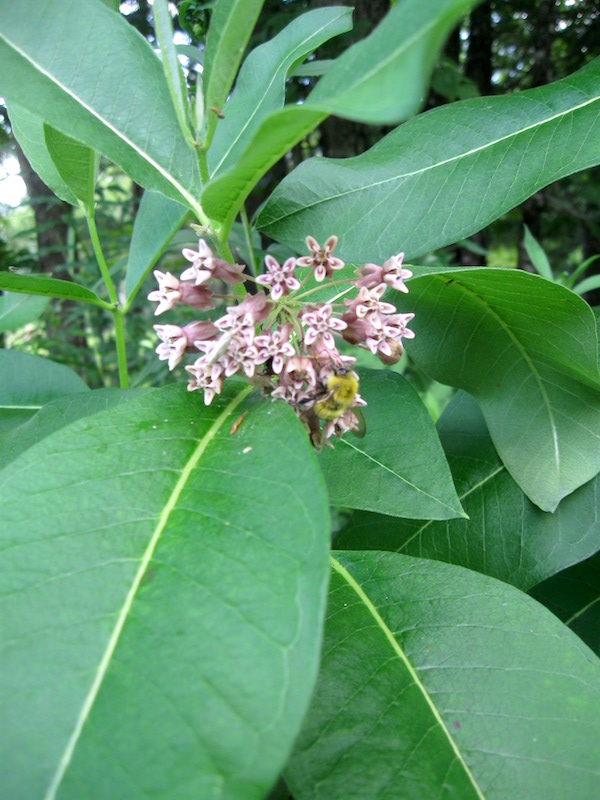
Past the blooms stage, they enter the “okra” stage. I’ll admit I really can’t stand okra, and I have no use for the vegetable. Milkweed pods, on the other hand, are much better in my opinion.
They’re not slimy, and they have a really pleasing crunch. I think while they look a bit like chopped okra, that’s only in appearance and not in flavor.
The seed pods need to be quite small for this “okra” preparation, and they only work when they’re about 1” long.
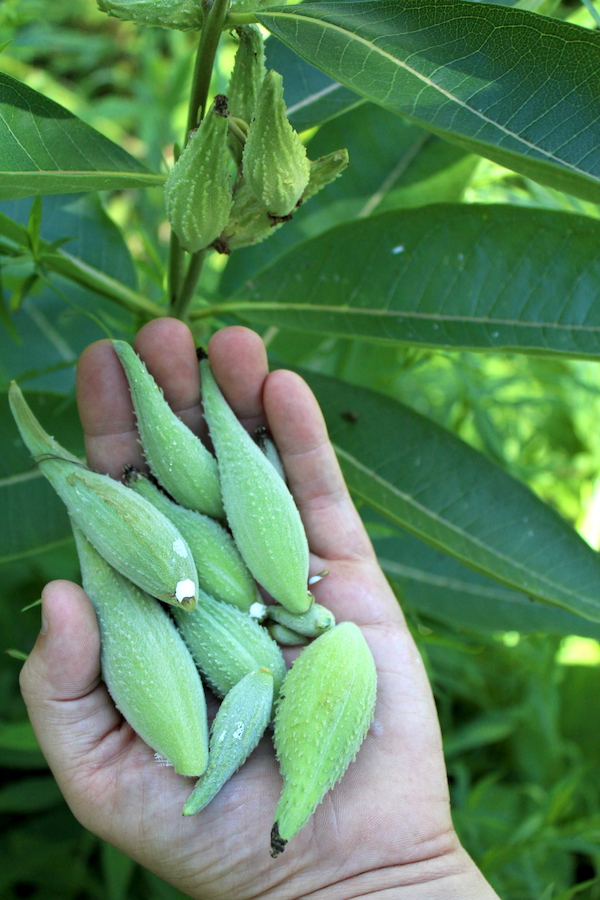
Once the seed pods are a bit bigger, they enter the “milkweed cheese” stage. When the seeds are completely white inside the pod, without any flecks of brown, they cook up like a cheese substitute. I’ve seen people make milkweed seed pod lasagna, and it mimics the texture of cheese inside the dish.
They don’t, in my opinion, actually taste anything like cheese. Imagine it a bit more like tofu.
Something that will take on the flavors of other things, and in this case happens to have the texture of melted cheese. The texture goes a long way, and it makes you think of cheese, thus it can easily be used that way.
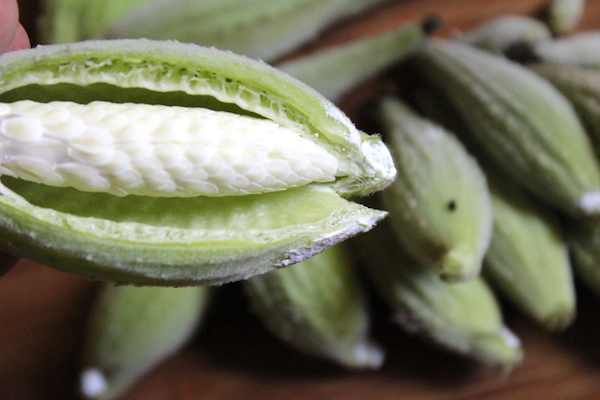
Honestly, I think the “okra” and “cheese” preparations actually go really well together. The chopped up pods provide a bit of crunch, and the “cheese” gives the suggestion of a rich dish, even though you’re only eating steamed weeds.
I’ll harvest a handful of pods of all sizes, chop the small ones and extract the immature seeds from the larger ones. Then steam both of them up and serve together.
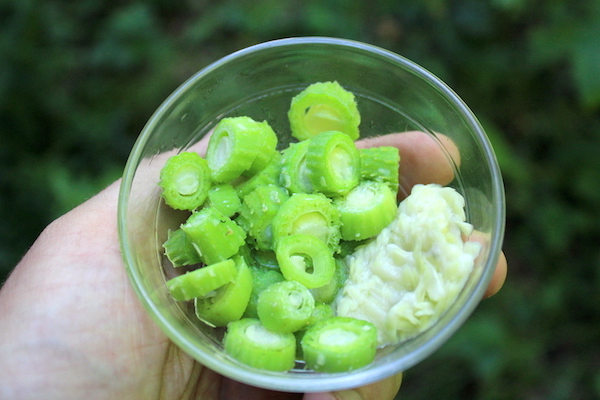
Finally, as if this fun plant hasn’t given enough…the fluffy mature seed pods are also useful. During WWII the fluffy seed pods were collected by school children to help with the war effort.
The fluff was used to fill life preservers, and it took 2 onion sacks full of the pods to make a single jacket. Enough was collected to make 1.2 million jackets…which gives you an idea of how much wild milkweed there must have been growing at the time.
These days, the seed pods are coveted by survivalists for all manner of uses from fire starting to filling field cots. In my book though, at this stage, their best use is saving to grow more milkweed…
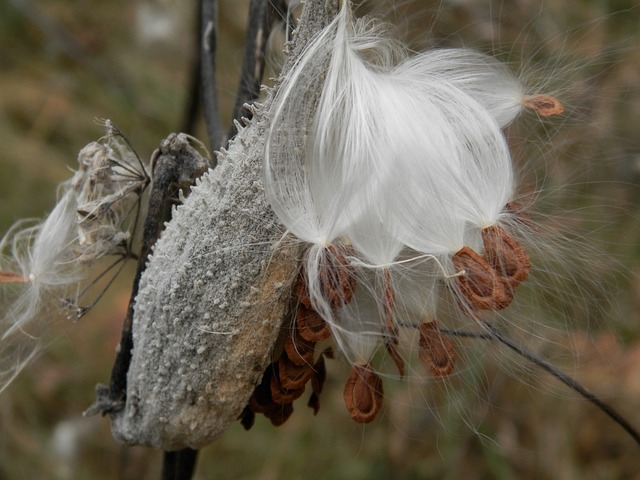
Excited to try milkweed? Or better yet, are you excited to grow in your own garden? I truly hope so.
If you do, let me know how you like it, and give me your thoughts on other ways to prepare milkweed. I love it fried in butter so much I haven’t experimented too much beyond that.
I’d love to hear how you eat your milkweed. In the meantime, here’s every milkweed recipe I can find…
- 5 Ways to Prepare Milkweed Flowers ~ Forager Chef
- Cream of Milkweed Soup ~ 3 Foragers
- Milkweed Flower Cocktail ~ Backyard Forager
- Milkweed and Radish Salad ~ Our One Acre Farm
- Milkweed Mushroom Moo Shu ~ Very Vegan Val
- Traditional Potawatomi Nation Preparations (Native American Milkweed Recipes)
One more time as a final reminder…There are a lot of species of Milkweed, and I’m referring to common milkweed (Asclepias syriaca). It does have toxic look-alikes, and if you’re not 100% sure on your ID, don’t eat it. I’d strongly suggest a good foraging guide, like The Forager’s Harvest, which contains detailed information on identifying and foraging milkweed, and/or a foraging course covering basic botany and ethical foraging. Cook milkweed thoroughly and start with small amounts to see how your body responds, as there’s always a small chance of reaction with any new food, foraged or otherwise.
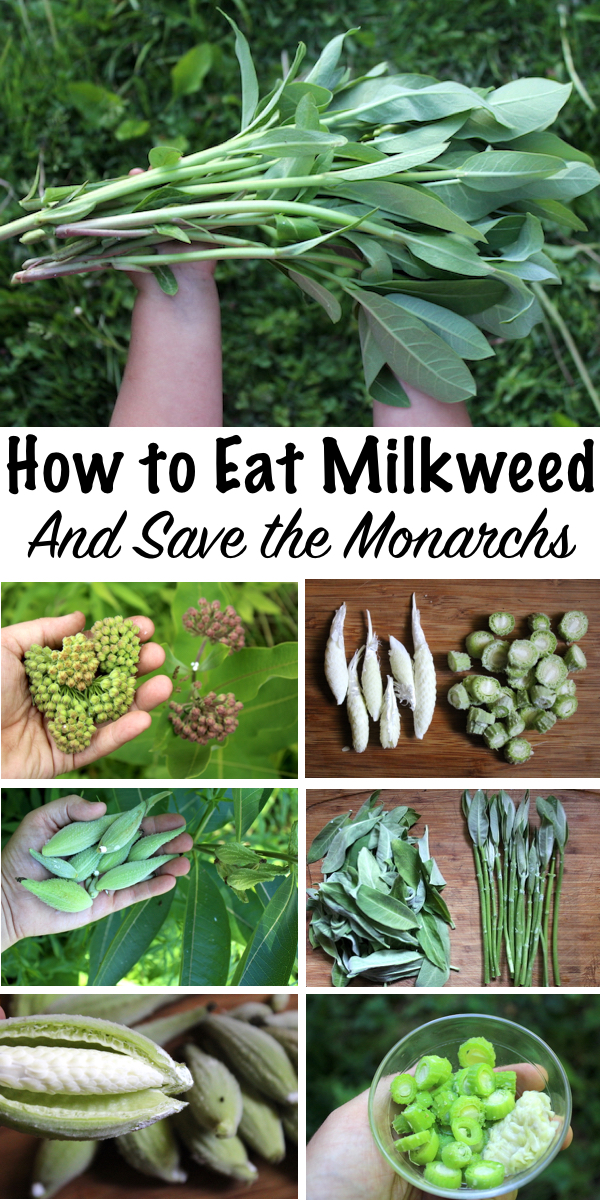
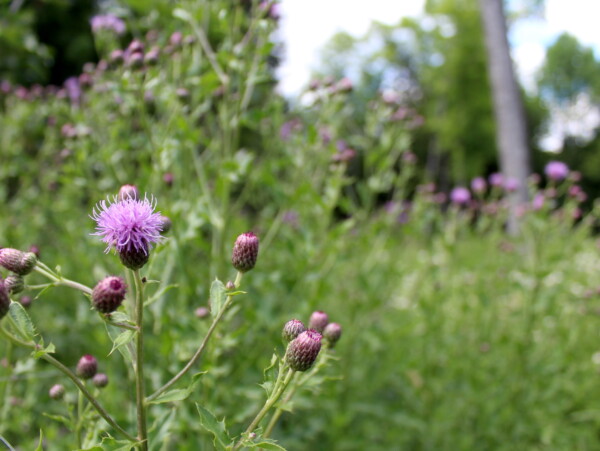
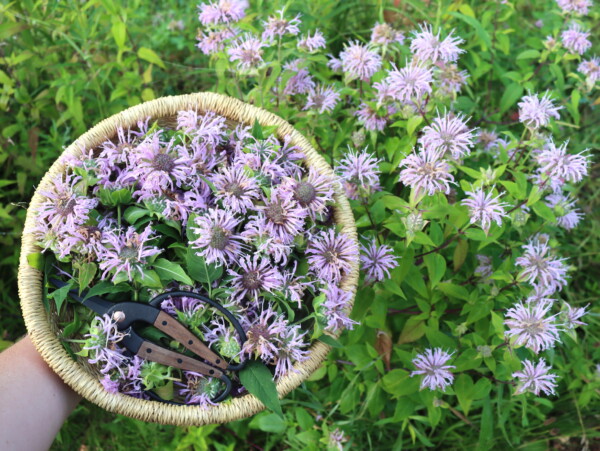
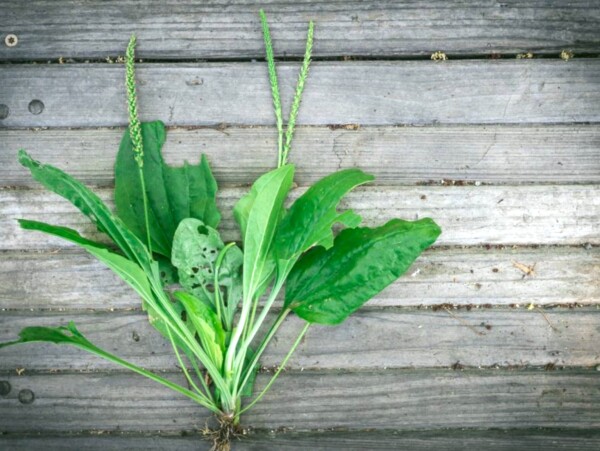
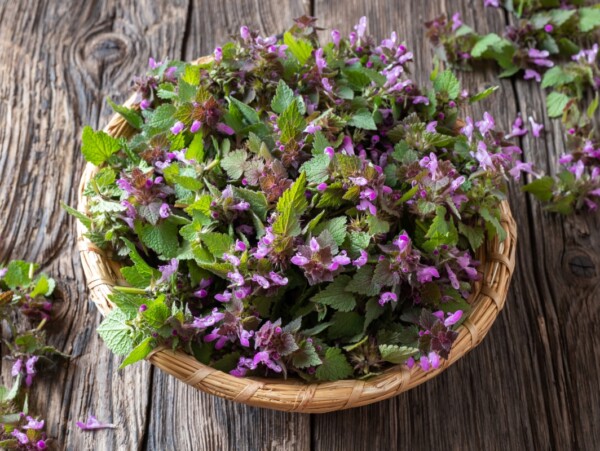
Just checking—If the milkweed has white sap it is not the edible kind you are talking about. I have lots of milkweed and always considered mine to be the common kind. It looks just like your pictures. In the comment section though it sounds like what you are talking about does not have white sap. Just an extra comment about helping the butterfies; if you cut it back at different times the butterflies will have tender milkweed all season long.
There are toxic look-alikes. If you aren’t 100% sure which milkweed you have, please don’t eat it. You can consult a reputable foraging guide or find an experienced forager in your area that can help you.
Wow! Thank you! Giving me further proof that I’m not crazy to let milkweed grow.
Local extension partnerships are great resources too. I have verified the species that is common in my locale, and it has been a historic favorite for indigenous peoples:
https://plants.usda.gov/plantguide/pdf/cs_assp.pdf
Although I have let milkweed grow in my chicken run for many years (with chastisement from neighbors), I don’t see many monarchs visiting. Maybe my milkweed is not the right maturity! Never thought of that. Also, while monarchs get more positive attention, they aren’t the only ones relying on milkweed. My kids have loved checking to see when the long-horned milkweed beetles show up each year, and they will always be a fond memory of childhood.
It was an absolute joy to see you write about the story my Dad has shared for years—he was one of those kids who gathered the fluff for the war effort!
I can’t thank you enough for this great article. It’s almost as if you were writing just for me.😊
You missed one. After the “cheese” stage when it actually grows seeds, but before its all dried out and fluff-the seeds have a cucumber taste. They are excellent on salads or in sauces for that cucumber taste.
Nice! That one I didn’t know =)
Here in the Northwest (Oregon), our indigenous milkweed is Asclepias speciosa (aka ‘Showy Milkweed’). I would expect this has the same edibility as A. syriaca, right ?
I honestly do not know, and I’d do a bit of research before I trying it. I’ve read that some of the other species of milkweed can cause really bad reactions, even burns or blindness from eye contact with the sap. Since I have never tried this species firsthand I have no advice for you other than do as much research as you can. I did a bit of googling and couldn’t find anything right off hand, unfortunately.
Imagine someone suffering permanent blindness from getting the sap in their eyes while harvesting milkweed to eat based on this article’s suggestion. Milkweed is also bad for our pets too. My dog almost died last year from chewing on a discarded common milkweed seed pod.
It’s important that each leaf be carefully looked at before picking, for eggs and caterpillars. No need to hurt the Monarch population any more than it already is.
I can tell you from sad experience that North Florida purple milkweed is truly toxic. I lost a yearling steer and a herd of goats to the stuff. The local extension agent claimed that our property had no toxic plants but an early 1950s farm yearbook gave us the info.
Orange butterfly weed is a species of milkweed which is medicinal in small doses, toxic in large. It is common in the upper South.
Sorry for your loss! That’s a lot of animals to lose, and I know how hard losing even one can be. I looked that one up (Asclepias Purpurascens) because I wanted to see if we had that species. At least according to this map, It grows along the whole east coast but stops before getting into Vermont and most of NH/Maine.
We grow Orange Butterfly Weed (Asclepias tuberosa) in our garden for the pollinators, but I hadn’t thought to look up uses for that one. Now I’m going to check into it, thanks!
Please remember that a lot of people who read things online are not the brightest. I think you need to be like bold print repeating yourself that it needs to be the right kind of milkweed and prepared the right way and in the right quantities etc. and that if they are not sure don’t even try. I can already see people who don’t read correctly getting sick.
I have been wanting to plant milkweed for years. I read it is toxic to dogs and cats. Is that the case for common milkweed, or is it safe for animals?
Honestly, I can’t help you with that one. It’s possible that it’s listed as toxic to them simply because it’s listed as toxic to humans, but I wouldn’t bet on that. Their digestive systems are very different than ours, and they’re not really meant to eat lots of vegetable material anyway. I wouldn’t suggest feeding it to dogs or cat for any reason. I’d be concerned if they eat it in the wild, because it needs to be cooked and because they have different dietary requirements than humans…so I have no idea how it’d work in their system.
My mom’s dog has a vicious reaction to eating pork, and she actually can’t keep it in the house for fear that the dog will find some small piece on the floor. You never know what your pet is going to eat or react to.
People need to be very careful about the exact type of milkweed they eat. Here in Oregon, Asclepias Speciosa has a latex like sap that is a skin irritant. I doubt that would be very tasty. Perhaps, since this is a web article and therefore could be viewed by people in many areas, you could put something in the first paragraph specifying that this is only the syriaca that you know to be edible.
Good point! I did have a warning further down in the article, but now I’ve moved it to the top so that the info is there in case someone doesn’t read the whole thing. Thanks for the suggestion, I’m sure this will avoid many potential questions from readers in other areas.
Where can I buy seeds? I live in a desert & foraging is a real challenge. Thanks!
There are a number of seed catalogs that carry it, more than you’d think. If the one you regularly buy from has herbs or native plants, it may well be in there. A few really good sources include Prarie Moon Nursery, Strictly Medicinal Seeds or Earthbeat Seeds (a small Vermont seed company)
Mind lien that milkweed is edible in so many stages! I have a ton in my garden “for the monarchs”! Now it’s for dinner! Thank you for posting this.
Where abouts in Vermont do you live. I live about 5 miles from the Southern Vermont border in Northwestern Mass. ?
We’re in Central VT, a bit outside Montpelier.
My grandpa was one of those schoolkids collecting the milkweed fluff for the soldiers vests to keep them warm!